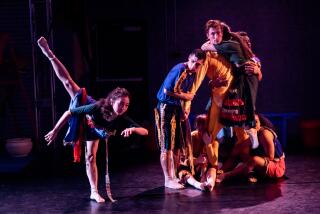DANCE REVIEW
- Share via
Anyone who wants to make a dance about indolence has a problem. Dance is movement; indolence is not. So choreographer Laura Gorenstein Miller set a task for herself and her Helios Dance Theater when crafting “The Lotus Eaters.” This 10-part work, about 75 minutes long, premiered Friday at the Eli and Edythe Broad Stage at the Santa Monica College Performing Arts Center.
Billed as a contemporary take on what is a brief episode in Homer’s “Odyssey,” Miller’s piece tells the story of Odysseus’ storm-tossed sailors cast up on an unknown island on their way home from the 10-year Trojan War. A few crew members eat the narcotic fruit that grows there and soon forget about home, duty and honor.
Miller presented the work in preview in October at the Cerritos Center for the Performing Arts. But in collaboration with her 10 dancers, she reworked and expanded it for the Broad Stage. Her imagination, she said in a Times interview that ran in October, was first sparked by seeing pieces of jewelry inspired by Alfred Lord Tennyson’s poem “The Lotus Eaters.” Further research led to Homer.
In Tennyson, the sailors choose to stay on the island. In Homer, the sailors are dragged back, weeping, to their ship, cast in irons and thrown under the rowers’ benches, as Odysseus and his crew flee as quickly as possible. Unlike either source, Miller made the Lotus Eaters predatory, but like Homer, she let her sailors escape.
The dance began swiftly, with five leather-clad guys bounding and vaulting onto the stage, like dangerous, merciless warriors. Soon they met five languorous women in silvery tunics. With elbows and wrists bent in images evoking praying mantises, the women plucked invisible fruit out of the air and fed it to the sailors, who fell at their feet in a dangerous swoon.
All that happened in about the first 10 minutes. So what was left to do? There followed slow duets and group sections, in which dancers carried one another on their backs, wrapped themselves in sensuous embrace or executed difficult partnering moves.
Eventually, to change the pace, there irrupted an energized group section, followed by an agonized solo for Sandra Chiu suggesting that the Lotus Eaters were themselves victims; then, seemingly out of nowhere, Chris Stanley’s solo in which he dragged himself across the floor. This part was labeled “home.”
Miller’s choreography was sometimes ingenious, but it did not long sustain interest. The dancers, most of whom were new to the company, worked diligently.
Rob Cairns composed the pre-recorded music, with Grant-Lee Phillips singing several of his original songs. Rami Kashou designed the costumes along stylish, classical Greek tunic lines. Alison Van Pelt created the flowering tree backdrop.
Whatever its virtues for music, speech or drama, the Broad has a problem with sightlines for dance. From a seat midway back in the orchestra section, one saw the heads of the audience in the front rows popping halfway above the edge of the stage. They looked, whimsically, like old-fashioned stage-light covers.
One could more or less adjust to this fact. Still, the net effect was to prevent viewing a dancer’s body complete from head to toe, which creates a major difficulty in appreciating choreography. Because the seats cannot be lowered, this looks to be a permanent issue at the Broad, which other- wise is so accommodating to performer and audience. For all that, the audience seemed delighted with the Helios Dance Theater performance.
--
More to Read
The biggest entertainment stories
Get our big stories about Hollywood, film, television, music, arts, culture and more right in your inbox as soon as they publish.
You may occasionally receive promotional content from the Los Angeles Times.










